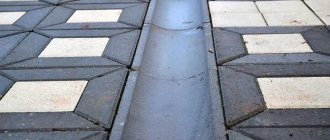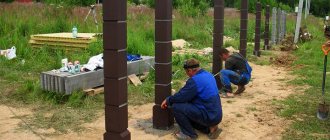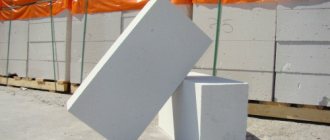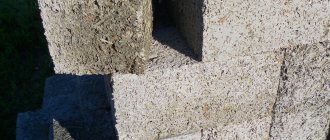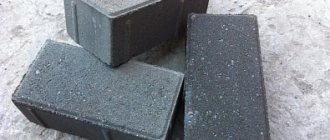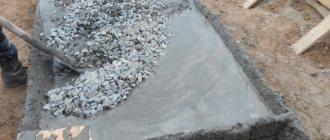Cement hydration is the process of reaction between the components of the mixture and water. It will not be possible to obtain a concrete solution without water, since it is when it is added that the stage of cement setting and then hardening begins. These two stages are considered the main ones for acquiring a mixture of declared characteristics (primarily strength, as well as other important parameters).
According to standards, the beginning of setting of Portland cement should occur 45 minutes or more after mixing the mixture. After the setting process is completed (up to 3 hours according to the regulations), hardening of the cement mortar begins. This is a longer process that can take years.
The concrete mixture reaches brand strength after 28 days, but even after this period, the process of hardening and gaining strength by the stone continues.
It is imperative to know how Portland cement sets and hardens. By paying attention to these stages, you will be able to avoid mistakes when mixing and pouring, which often lead to the solution losing its adhesive ability, reducing strength, deformation and other unpleasant consequences. This knowledge is also important for the production and use of various additives to cement, which change certain characteristics and properties of the monolith and can prolong or shorten the stages.
Cement hydration - what is it?
This term refers to the physical and chemical process in which the components of cement powder bind to the liquid. To understand the features of this action, you need to carefully examine the composition of cement. Only then will it be possible to understand how the ingredients of the powder interact with water, which affects the setting period of the cement, and to study the other characteristics of the building material. It contains active mineral additives, thanks to which the concrete slowly gains the required level of strength. Whatever the brand and type of cement, it contains four minerals:
- dicalcium silicate;
- tricalcium silicate;
- tricalcium aluminate;
- tetracalcium aluminoferite.
Figure 1. Chemical composition of concrete
Conducting experiments to establish setting times
Setting the setting time is regulated by GOST 310.3-76. To obtain normal thickness of the binder dough, use the Vicat device shown in Figure 1.
Figure 1 – Design of the Vicat device
A cement mortar of a pre-calculated composition is mixed in a spherical metal bowl. Then the trapezoidal ring is filled with the resulting volume of cement mixture. The container is placed under the needle.
Important! A pestle is used to measure the density, and a needle is additionally placed to determine the setting time.
An acceptable density value is considered if the pestle of the device does not reach the plate at a distance of 5 to 7 mm. In case of deviations in indicators, the water-cement (W/C) ratio is adjusted.
Before starting work, it is important to make sure that the device is operating correctly, and that parts in contact with the mixture must be coated with machine oil.
To set the setting time, attach a needle to the pestle. The needle is immersed in the dough at intervals of 10 minutes. The beginning of hardening is considered to be the period required from the moment water is added to the binder until the needle reaches 2 to 4 mm from the bottom plate. The end of setting occurs when the needle is immersed by a maximum of 2 mm.
False seizure (FS) is determined using the same device, only instead of a pestle a truncated cone is installed. Before starting work, it is necessary to mix a solution of cement, fine aggregate and water. The ratio of the components used is regulated by GOST R 56588-2015. The cone is immersed in the mold with the mixture after 15 minutes, and then after 1 hour the readings of the device are recorded. False grasping is considered if the measurements correspond to the first type, according to Table 1.
Table 1 - Determination of false setting depending on test results
| Setting type | Depth of immersion of the cone into the test sample (solution), mm | ||
| After mixing | After secondary mixing after 30 minutes | ||
| After 15 minutes | After 60 minutes | ||
| First type of drug | Less than 15 | Less than 10 | More than 45 (inclusive) |
| Second type of drug | From 15 (inclusive) to 50 | From 10 (inclusive) to 50 | More than 45 (inclusive) |
| Fast setting | Less than 50 | Less than 50 | Less than 45 |
Influence of components on hydration
Each of these components is extremely important, they all have specific characteristics that help influence first the setting and then the hardening of cement. Some begin to immediately interact with moisture, others act gradually, after a certain time. Let's look at how each ingredient affects hydration:
- Dicalcium silicate begins to work only a month after the concrete has hardened. Before this, he does not participate in the process, waiting for his turn. The presence of special plasticizers present in the concrete mixture helps to significantly reduce the period of inactivity without the risk of deteriorating the strength of the material. This ingredient functions in the long term, allowing the concrete poured monolith to be strengthened over time.
- Tricalcium silicate functions actively throughout the entire period of cement existence. This substance is the basis of the mixture, it is what starts the process called hydration. When it starts, heat is released, which significantly increases the temperature of the mixture.
- Tricalcium aluminate provides the setting process because it is the most active component. This substance ensures a steady increase in the strength of the monolith in the very first few days after pouring. Then the ingredient stops working.
- Tetracalcium aluminoferite, although it has a minimal effect on the hardening and strength gain of the monolith, is still extremely important. His work starts at the finishing stage, when the cement hardening procedure has long been started. This component improves the achieved characteristics, thereby completing the process.
Each listed mineral component determines the quality of cement and ensures the correct course of the hydration process. When the powder is mixed with water, intracrystalline bonds immediately appear inside the solution, which determine the slowly increasing strength, due to which the concrete ultimately acquires a state similar in parameters to artificial stone.
Features of hydration
Due to the short setting period of cement (45–90 minutes), the mixture must be prepared shortly before use, leaving time for pouring until the end of the reaction, when it is no longer possible or useless to process the mixture. In order for the hydration reaction to fully occur, the proportions of the volumes of cement and liquid must correspond to a value of 3:2. Only a quarter of the water molecules are chemically bound to the powder, the rest are stored in the concrete pores, having a physically bound appearance.
If the amount of water decreases, hydration will not occur completely; if its volume increases, capillary pores will develop inside the monolith, which will reduce its strength. The instructions for each specific brand of cement or concrete always inform you about the exact required volumes of components.
Water cement ratio
The main parameter for mixing a concrete mixture is the water-cement ratio. This is the relative value (by weight) of the amount of pure cement in the batch to the water with which the mixture is mixed.
The strength, water resistance and mobility of the finished concrete directly depend on this ratio.
. Of course, the final characteristics of concrete are affected not only by the amount of water, but also by its quality.
A very common reason for a decrease in the strength of concrete, slowing down and even stopping the hardening process is the chemical composition of the water in which the solution is mixed.
Water quality is standardized by GOST 23732-79 “Water for concrete and mortars. Technical specifications"
This standard sets the following requirements for mixing water:
- Water should not contain impurities of minerals, traces of petroleum products, fats and organic residues.
- The content of organic surfactants, phenols and sugars should not exceed 10 mg/dm3.
- The pH level should be between 4 and 12.5
- Oxidability should not exceed 15 mg/dm3.
It is clear that all these requirements are easy to comply with in laboratory conditions. But what about mixing concrete at home or in the country, where it is not always possible to measure chemical indicators.
In this case, we strongly recommend adhering to a simple rule - mix with drinking (or conditionally drinking) water. This can be water from a well, a well, a water supply system, or natural water that has undergone purification. The biggest mistake in suburban construction is using water from a nearby pond, ditch or puddle. Even with external transparency and cleanliness, such water is most often oversaturated with organic and mineral pollutants, which will interfere with the normal process of concrete hydration and adversely affect its quality.
Composition of cement and its hydration
As previously stated, the hardening of Portland cement is influenced by four mineral ingredients obtained in the production of this binder product. The behavior of each component is significantly different and depends on the stage of setting of the monolith. Some components react immediately to the appearance of water, others wait their turn, and some do not seem to participate in the process at all.
But all of them, when interacting with water, begin a chemical reaction that ensures growth, then adhesion, and ultimately precipitation of crystals of moisture-saturated compounds. If we consider the event from the point of view of a chemist, then it is crystallization.
Requirements for construction work in winter
We indicate the most important points of winter construction:
- bricks or blocks for masonry must first be cleared of frost, ice or snow;
- cement should be stored in a dry place;
- sand and crushed stone must contain a minimum amount of moisture;
- It is advisable to carry out the laying by several workers so that the process is completed as quickly as possible;
- if a break is necessary, it is advisable to cover the finished masonry with film or roofing felt;
- mix the solution in a warm room;
- for winter work, use only cement grade M 500, not lower;
- winter masonry is done with thin seams, so there will be less heat loss;
- it is necessary to equip a heated house for workers where they can warm up;
- pouring concrete at minus 5 must be done with the mandatory addition of anti-frost additives to the solution.
An interesting article on the topic here: Building a house in winter - features of construction in cold weather
Main stages of hardening
The solidification process of the monolith itself is divided into two stages. First the solution sets and then hardens. The first stage lasts about a day after preparing the mixture. Its speed is mainly affected only by the ambient air temperature:
- When the thermometer reads around 20°C, the concrete will set in about a couple of hours after mixing. Final setting is guaranteed after 3 hours. That is, the setting stage lasts about an hour.
- If the air temperature is 0°, this process takes longer, it can even last 20 hours. This is due to the delay in the start of setting - the process starts only after 6–10 hours.
Figure 2. Concrete
At the same time, specific additives become an influencing factor that determines the speed of setting. They can speed up or slow down a chemical reaction.
As long as the setting stage lasts, the concrete remains mobile. It is subject to any mechanical stress. When carrying out any measures regarding a monolith that has not yet had time to set, you need to understand that they extend the period of its initial setting.
The final stage of obtaining a high-quality monolith is hardening of the solution. It occurs immediately after the completion of the previous phase. This process itself is extremely slow, often taking several years. In the very first days of hardening, the monolith is still dynamic and has a nonlinear state.
Unnatural increase in hardening rate
Since concrete hardens very slowly at sub-zero temperatures, and construction time is usually limited, builders have come up with a couple of ways to speed up this process.
The most common ones are the following:
- Adding special additives to the solution;
- Heating of concrete with an electric cable;
- The use of more cement in the composition.
Now let’s take a closer look at the highlights of each of these methods.
Applying modifiers
Much more often, when carrying out construction work in winter, the following types of modifiers are used:
- Additives type C - concrete hardening accelerators;
- Type E additives are water-replacing accelerators.
The most effective and common is potassium chloride. But its part in the total mass must be no more than 2%.
It must be stated that hardening accelerators do not affect the quality level of concrete, but at the same time they do not protect it from freezing. In addition, their use does not negate the requirements for the temperature of the solution and the implementation of measures to protect it from freezing.
Note! When making a screed or foundation, it is necessary to immediately consider the presence of holes and channels for communications, since subsequent processing will be very labor-intensive. In addition, it will require a special tool; for example, cutting reinforced concrete with diamond wheels requires the presence of a wonderful grinder.
Concrete heating
A special cable is usually used to heat concrete. This is perhaps the most natural way. The only thing is that in order to achieve a positive result, certain heating instructions must be strictly followed (also determine how the concrete is heated with a welding machine).
Unlike the previous method, heating helps protect concrete from freezing. Accordingly, there is no need to calculate at what temperature the concrete hardens and how long this process continues, since it is possible to ensure normal conditions.
Increasing cement dosage
This method can be used at low temperatures. The increase in dosage should be small, otherwise the quality level of concrete and its durability may be significantly reduced.
Advice! If, after the mortar has hardened, it becomes necessary to drill it, then the most effective method is diamond drilling of holes in the concrete.
Raw materials
Cement is produced in factories that are located in close proximity to rock mining sites that serve as raw materials for building materials. Natural raw materials for cement include:
- carbonate minerals. These include limestones, dolomites, marls, and mixtures of these rocks. Most of these minerals were formed at the bottom of seas and lakes by sedimentation. The thickness of the layers can reach several hundred meters. The crystal lattice of different types of carbonate minerals has different degrees of stability. This determines their ability to fuse with other components during the cement manufacturing process.
- clay materials. Fine rocks that were also formed by sedimentation. They consist of a base - a clay substance and a large number of impurities. When water is added, this raw material increases in volume and becomes viscous and plastic.
Let us dwell in more detail on the main raw materials that make up cement.
Shrinkage of concrete during hardening
Shrinkage and expansion of concrete are taken into account when designing concrete structures. The process of concrete hardening is accompanied by a change in its volume
When hardening in air, concrete shrinks; when hardening in water, it does not change in volume or swells slightly.
In large masses, concrete can expand due to heating up to 30-60° (due to internal heat release). The magnitude of this expansion significantly exceeds the shrinkage. The coefficient of thermal expansion of ordinary concrete is 0.00001. The shrinkage coefficient in calculations is usually taken to be 0.00015, i.e., per 1 m of length of a concrete structure, the shrinkage is 0.15 mm.
Shrinkage is caused by water pressure in the capillaries of the cement stone as it evaporates. Experiments have established the following:
- The higher the content of cement and water in it, the greater the shrinkage of concrete;
- fast-setting and high-strength Portland cements, as well as pozzolanic Portland cement, usually cause greater shrinkage of concrete;
- shrinkage is greater with fine-grained and porous aggregates;
- wet hardening mode and special coatings do not allow concrete to quickly dry out from the surface, thereby eliminating the consequences of large and uneven shrinkage (cracks)
The shrinkage and expansion of concrete is taken into account when designing structures and carrying out concrete work; special joints are installed in long-term structures; in massive structures, concrete is laid in separate blocks, and cements with minimal heat generation and shrinkage are used. This is especially important when choosing cements for hydraulic structures

